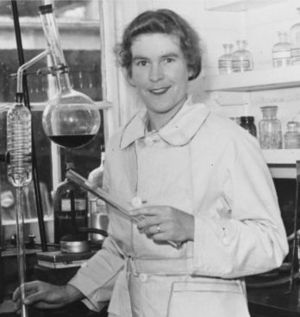Greta Stevenson facts for kids
Quick facts for kids
Greta Stevenson
|
|
|---|---|

Greta Stevenson circa 1941
|
|
| Born |
Greta Barbara Stevenson
10 June 1911 Auckland, New Zealand
|
| Died | 18 December 1990 (aged 79) |
| Known for | Contributions to mycology |
| Scientific career | |
| Fields | Mycology |
| Author abbrev. (botany) | G.Stev. |
Greta Barbara Stevenson (born June 10, 1911 – died December 18, 1990) was an important scientist from New Zealand. She was a botanist, which means she studied plants, and a mycologist, meaning she studied fungi like mushrooms. She discovered and described many new types of gilled mushrooms.
Contents
Greta Stevenson's Early Life and Education
Greta Stevenson was born in Auckland, New Zealand, on June 10, 1911. She was the oldest of four children. Her father, William Stevenson, managed a company that made canned food. In 1914, when Greta was young, her family moved to Dunedin.
Greta went to Columba College from 1925 to 1928. After that, she attended the University of Otago in 1929. She worked hard and earned her first degree, a Bachelor of Science (BSc), in 1932. Then, in 1933, she received a Master of Science (MSc) in botany with top honors. Her master's project was about the life history of a rare plant called Korthalsella.
Advanced Studies and Family Life
After finishing her studies in New Zealand, Greta moved to London, England. There, she attended the Imperial College of Science and Technology. She earned her PhD, which is a very high university degree, in mycology and plant pathology. Plant pathology is the study of plant diseases.
In 1936, Greta married Edgar Cone, who was studying chemical engineering. They had two children together. When they returned to New Zealand, Greta worked for the Wellington City Council as an analyst. She also worked as a soil microbiologist for the Department of Scientific and Industrial Research. This meant she studied tiny living things in the soil. She also taught science at several secondary schools.
Greta was also a very keen mountaineer. She even climbed the east peak of Mount Earnslaw with a group of only women. This was a big achievement at the time!
Later Career and Recognition
Throughout her career, Greta Stevenson worked at several different places. These included University of Otago, Wellington City Council, Cawthron Institute in Nelson, Imperial College London, Crawley College of Further Education, and King Alfred's College.
Greta Stevenson passed away in London on December 18, 1990, when she was 79 years old.
In 2017, Greta was honored by the Royal Society Te Apārangi. She was chosen as one of their "150 women in 150 words". This celebrated the important contributions women have made to knowledge in New Zealand.
Greta Stevenson's Research on Fungi
Greta Stevenson was especially known for her work studying fungi. She wrote three books about ferns and fungi, and she even drew all the pictures herself!
Her most famous work was a series of five papers about the Agaricales of New Zealand. Agaricales are a large group of gilled mushrooms. These papers were published in the Kew Bulletin between 1962 and 1964. In these papers, she described more than 100 new species of fungi that had never been known before!
Greta also collected many important samples of New Zealand fungi. Her collection, along with those of other scientists like Marie Taylor and Barbara Segedin, became the start of the New Zealand Fungarium. This is a special collection of fungi samples used for scientific study.
Fungi Named After Greta Stevenson
When a scientist discovers a new species, sometimes other scientists will name a new species after them to honor their work. This is called an "eponymous taxon." Two fungi species have been named after Greta Stevenson:
- Entoloma stevensoniae E.Horak (1980)
- Hygrocybe stevensoniae T.W.May & A.E.Wood (1995)
See also
 In Spanish: Greta Stevenson para niños
In Spanish: Greta Stevenson para niños

